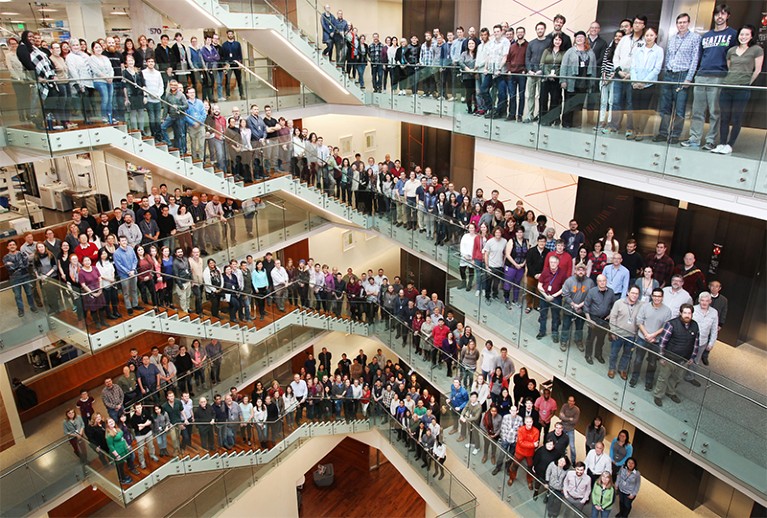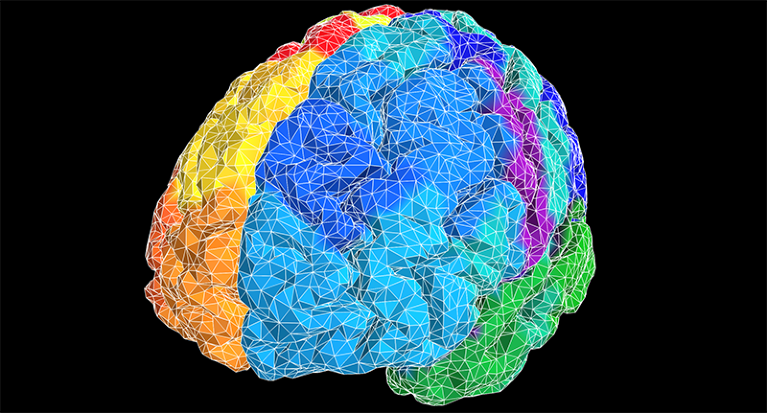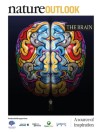
Staff members at the Allen Institute in Seattle, Washington, a non-profit research organization that includes the Allen Institute for Brain Science.Credit: Allen Institute
Christof Koch was finishing his PhD on theoretical brain modelling in 1982 when he received a worrying telegram from his adviser, Tomaso Poggio.
Poggio, who had relocated to the United States from what was then West Germany the previous year, warned Koch, who was planning to join him, that he might struggle to find a US position. After getting his PhD from the Max Planck Institute for Biological Cybernetics in Tübingen, Koch had hoped to take up a postdoc role in Poggio’s new laboratory at the Massachusetts Institute of Technology in Cambridge.
But Poggio had discovered that there was already someone in the United States making computational brain models and, Koch says, he wrote, “I’m worried, are there enough faculty positions to cover two people modelling the brain in the entire United States of America?”
That seems funny now, says Koch, because today there’s no shortage of such positions; he estimates that 5,000 people in the United States do something similar. “Now every university will have two, three, four, five faculty that do nothing but theoretical neuroscience, computational neuroscience, data science in the brain,” he says. And there are now many other jobs in neuroscience, at places ranging from conventional research universities and dedicated institutes to companies developing neurotechnology. “There’s a variety of opportunities, vastly more than ever before,” Koch says. “It’s a fantastic time to study the brain.”
On the map
Many of those opportunities come from the rise of large-scale national and international projects dedicated to understanding the human brain. In the past six years, the European Union, the United States and Japan have all launched multi-year, multimillion-dollar projects to suss out the workings of the brain — how it learns, how it controls behaviour and how it goes wrong. Koch himself participates in some of those projects in his role as chief scientist and president of the Allen Institute for Brain Science, a non-profit research organization in Seattle, Washington, endowed by the late Microsoft co-founder Paul Allen. The institute is building a catalogue of the various cell types in both human and mouse brains, called the Allen Brain Atlas.
Other countries — Canada, Australia, South Korea and China — are in the early stages of their own large-scale efforts. Along with the goal of describing in detail just how the brain works at various levels, from the cellular to the behavioural, the hope is that these projects will lead to new ways to treat brain diseases and mental-health conditions, as well as advance artificial-intelligence (AI) technologies. To do that, investors are providing the projects with billions of dollars in new funding, creating career opportunities for not only neuroscientists but also physicists, mathematicians, chemists, materials scientists and medical specialists, all of whom must be trained to work across disciplines.

Visualization of the whole brain, simulated using real data from TheVirtualBrain framework. Colours represent different groups of connected neurons.Credit: TheVirtualBrain
The European Union’s effort, a 10-year, roughly €1-billion (US$1.1-billion) programme called the Human Brain Project (HBP), was launched in 2013. The sprawling endeavour directly employs 500 scientists spread across universities, hospitals and research centres throughout Europe, and provides funding that supports many more. Its aim, explains scientific research director Katrin Amunts, who studies the brain at Heinrich Heine University Düsseldorf in Germany, is to develop tools for studying the brain and create an infrastructure of supercomputers and data-sharing platforms that will allow researchers to do more comprehensive studies than they could on their own. “In ten years we will not have understood the human brain. It is simply too complex and we still have to learn a lot,” she says.
That does not mean, however, that the world will have to wait for some vague future date to see any benefits. For instance, Viktor Jirsa, a physicist who directs the Institute of Neuroscience Systems at Aix-Marseille University in France, has used information about how individual neurons are linked together in the brain — the ‘connectome’ — to develop the Virtual Epilepsy Patient. He takes readings of the brains of people experiencing epileptic seizures and uses the measurements to pinpoint more precisely the sources of those seizures. The hope is that, by targeting specific neural connections involved in a particular person’s epilepsy, brain surgeons can perform more targeted treatments and improve the success rate of surgery to stop epileptic seizures beyond the current success rate of roughly 50%. Jirsa is in the middle of a randomized clinical trial to test the idea on about 350 people.
Another practical benefit Amunts hopes the HBP will yield is a visual prosthesis that could restore sight to people who are blind. This is being developed by neuroscientist Pieter Roelfsema, who leads the Vision and Cognition Group at the Netherlands Institute for Neurosciences in Amsterdam. Building a bridge between the biological understanding of the visual cortex and the engineering result of a robotic eye is the sort of outcome the HBP aims to achieve, she says. Along the way, researchers are developing better AI algorithms to decipher brain functions, and virtual robots in which to test whether the mechanisms they think they’ve uncovered would work in people.
Amunts doesn’t expect the HBP to uncover all of the brain’s secrets, and welcomes other national programmes. “Any project in the world cannot address all questions related to the human brain,” she says.
Building circuits
With megaprojects such as the HBP, as well as other, smaller national programmes (see ‘Projects around the globe’) and their associated funding, neuroscience is a growth area. “It’s a really great time for young people to enter the field,” says Walter Koroshetz, a neurologist who directs the US National Institute of Neurological Disorders and Stroke. Although there’s plenty of opportunity for researchers in biology and medicine, there’s also a great need for people from other disciplines — particularly from fields that will help to develop tools to push the research forward. “The people who are going to build those are not the biologists, they’re the engineers and the materials scientists and the physicists,” says Koroshetz. “And the people who are going to look at neural activity and try to figure out what it means, what’s the language of the brain, are going to be mathematicians and computer scientists.”
In the United States, the Brain Research through Advancing Innovative Neurotechnologies (BRAIN) Initiative launched in 2014, with a planned budget of between $300 million and $500 million a year for 12 years. Much of it is conducted under the auspices of the US National Institutes of Health. Also participating are the National Science Foundation; the Defense Advanced Research Projects Agency, which develops cutting-edge technologies for military use; and the Intelligence Advanced Research Projects Activity, which does the same for the intelligence field.
The goal during the project’s first five years , says Koroshetz, was to develop tools that would allow researchers to monitor and manipulate brain circuits — the collection of neurons that work together to perform particular functions, such as coordinating muscle movement. Scientists have an understanding of the brain at the cellular level, including how genes influence the form of brain cells, how neurotransmitters and receptors work and how synapses are formed and strengthened. But they didn’t have the tools to watch and understand the activity of circuits, the next level up in the hierarchy of brain function. Tools that might help include proteins that can be inserted into specific cell types to make them fluoresce when calcium flows through an ion channel, for instance, or targeted receptors that can turn the firing of neurons on or off in response to light or a chemical stimulus.
Armed with such tools, scientists can begin to look at what goes wrong in various disorders that don’t have obvious physical signs, unlike Alzheimer’s disease, in which plaques are present, or brain tumours. Diagnosis of many mental-health conditions is based on behaviour, but it could prove useful to see what’s happening in the brains of people with these conditions, and that could also lead to new treatments. “There’s no pathology in chronic pain, schizophrenia, depression or Tourette’s syndrome, but they’re clear circuit disorders,” Koroshetz says. “You couldn’t even approach trying to understand what was wrong with the circuit before.”
Brains needed
To build and use those tools, researchers require a transdisciplinary mindset, says Yves De Koninck, director of the Neurophotonics Centre in Quebec, Canada. The centre brings together neuroscientists, physicists, chemists, mathematicians and engineers. They develop hardware (such as fibre-optic probes and microscopes), software to analyse and model brain data, and what De Koninck calls “wetware”, such as tools that allow researchers to control living cells using light. “Brain science has to do with everything, from understanding the fundamentals of cell function all the way to how society is built, so we really need people that are able to bridge between different disciplines,” De Koninck says.
De Koninck runs a transdisciplinary training programme at the Neurophotonics Centre. He is also part of the Canadian Brain Research Strategy, a collaboration of various Canadian brain-research groups. One emphasis, he says, is forming partnerships between institutions, disciplines and nations. “We can’t, in the field of neuroscience, understand the complexity of the brain by continuing each to work alone,” he says.
Amunts agrees that neuroscience needs researchers who have trained in a variety of fields. “Such people are very rare at this moment, so we are starting to educate them.”
For instance, Heinrich Heine University, where Amunts directs the Cécile and Oskar Vogt Institute of Brain Research, offers a master’s degree in translational neuroscience, and some of the courses students take as part of the degree are sponsored by the HBP. Early-career scientists who want to participate in brain research need to be willing to learn from colleagues in other disciplines, Amunts says.
And the field only seems likely to grow, brain researchers say (see ‘Getting into brain research’). “It is a golden age of brain science,” says Koch. “It also impacts people much more than studying the heart or the liver, because who you are depends on your brain. If your heart is faulty, you can get a heart transplant and you are still you. Who we are, how we think, our dreams, our aspirations, our very consciousness is very closely tied to the brain.”


 How neuroscience is breaking out of the lab
How neuroscience is breaking out of the lab
 Neuroscience starts talking
Neuroscience starts talking
 How AI and neuroscience drive each other forwards
How AI and neuroscience drive each other forwards
 Nature Outlook: The brain
Nature Outlook: The brain







